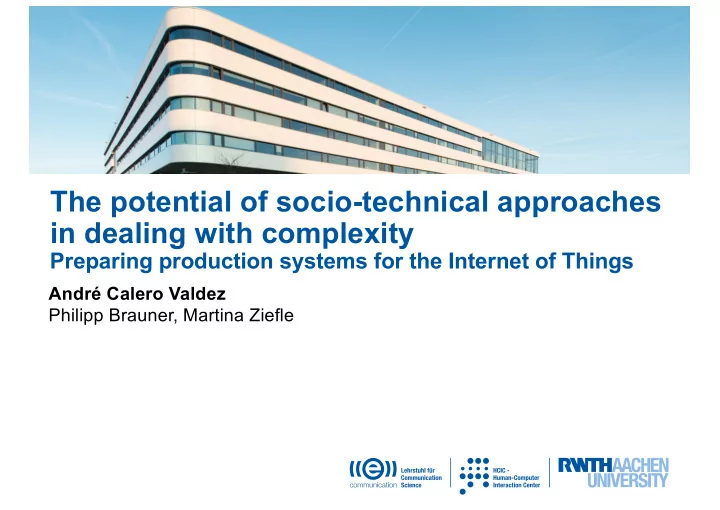

The potential of socio-technical approaches in dealing with complexity Preparing production systems for the Internet of Things André Calero Valdez Philipp Brauner, Martina Ziefle
Industrie 4.0 The Internet of Things and Production Pervasive digitalization Integrated cyber-physical systems - Improved capacity utilization - Improved cost-effectiveness Foster innovation Potential of socio-technical approaches André Calero Valdez
Challenges in Industrie 4.0 What will we have to adapt to? Transition in engineering work - Self-optimizing, individualized, integrated processes - Regulatory and monitoring tasks Challenges in - Managing knowledge - Sharing responsibility - Dealing with complexity Potential of socio-technical approaches André Calero Valdez
Socio-Technical Systems (according to Leavitt 1964) What drives a STS? Humans and Technology - Solve a specific task Technical Subsystem - Mutual benefits Task Technology Quality depends on interactions of Output Input subsystems Actor Structure/Role Designed features with linear cause- effect Social Subsystem Non-designed non-linear emergent features => Complexity Potential of socio-technical approaches André Calero Valdez
Complexity in Human Machine Interaction Not all complexity is created equal Perceptual complexity - Gestalt theory, homogeneity, simplicity, information entropy, form complexity, visual chunking, pop-out, etc. Task -complexity - Multi-variate decision making, goal complexity, input complexity, process/training, time, presentation, etc. Cognitive complexity - Relational knowledge (t,s,b), planning tasks, categorization, narrativity, uncertainty, risk Potential of socio-technical approaches André Calero Valdez
Use Cases When does complexity matter? Visualization of complex data (ERP) - Monitoring tasks, multivariate tasks - Decision-Support => Consequences Simulation and scientific visualization - Burden of knowledge - High-dimensional data Implications for UI Design Processes Associated Costs? Potential of socio-technical approaches André Calero Valdez
Experimental Example: Reading of numerical data Poor usability is pricey in scenarios with high complexity 25000 25000 20000 20000 Reaction time [ms] Reaction time [ms] 15000 15000 simple simple medium medium 10000 10000 difficult difficult 5000 5000 0 0 short (4 lines) long (8 lines) short (4 lines) long (8 lines) Table length Table length Potential of socio-technical approaches André Calero Valdez
Addressing complexity in STS Research Framework for STS What aspects influence complexity in Industrie 4.0? Potential of socio-technical approaches André Calero Valdez
Research Framework for STS What factors should we focus on? Task domain Technical Subsystem Technology Task Visualization, Urgency, Habituation, Urgency Decision Support, Strategies Interactions - Shorter Time-Frames Understanding Design - Faster planning Habituation Structure/Role User Responsibility, - Repetition frees cognitive resources Skills, Human Delegation, Factors, Diversity Communication - Small changes? Social Subsystem Strategies - Good strategies (best practices) - Circumvention strategies Potential of socio-technical approaches André Calero Valdez
Research Framework for STS What factors should we focus on? User domain Technical Subsystem Technology Task Visualization, Urgency, Habituation, Skills Decision Support, Strategies Interactions - HR-Management of competencies Understanding Design - Learning on the job Human Factors Structure/Role User Responsibility, - Ergonomics Skills, Human Delegation, Factors, Diversity Communication - Task-Fit Social Subsystem Diversity - Motivation & Values - Demographic changes Potential of socio-technical approaches André Calero Valdez
Research Framework for STS What factors should we focus on? Technology domain Technical Subsystem Technology Task Visualization, Urgency, Habituation, Visualization Decision Support, Strategies Interactions - Perceptual mapping Understanding Design - Entropy detection & Hypothesis generation Structure/Role User Decision Support Responsibility, Skills, Human Delegation, Factors, Diversity Communication - Transparency & comprehensibility - Trust Social Subsystem Interactions - New forms of interaction - Adaptive Interfaces Potential of socio-technical approaches André Calero Valdez
Research Framework for STS What factors should we focus on? Structure domain Technical Subsystem Technology Task Visualization, Urgency, Habituation, Responsibility Decision Support, Strategies Interactions - Shared between algorithm or user Understanding Design - Influence on Motivation Delegation Structure/Role User Responsibility, - Benefit trade-offs Skills, Human Delegation, Factors, Diversity Communication (performance/learning) - Adjustable complexity Social Subsystem Communication - Planned, organizational development - Ad-hoc understanding Potential of socio-technical approaches André Calero Valdez
Unification of four domains Understanding Task and User Designing Technology and Structure Technical Subsystem Technology Task Visualization, Urgency, Habituation, Decision Support, Strategies Interactions Understanding Design Structure/Role User Responsibility, Skills, Human Delegation, Factors, Diversity Communication Social Subsystem Potential of socio-technical approaches André Calero Valdez
Summary Thank you very much for your attention! Socio-technical systems - Linear and non-linear features Different forms of complexity - Visual, Cognitive, Task Usability is crucial in complex environments Research framework investigating complexity Potential of socio-technical approaches André Calero Valdez
Recommend
More recommend